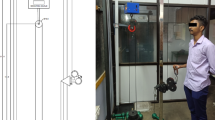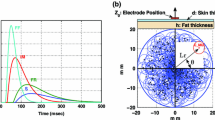Abstract
Muscle strength testing has long been an important assessment procedure in rehabilitation setups, though the subjectivity and standardization of this procedure has been widely debated. To address this issue, this study involves the use of Electromyogram (EMG) features that are intuitively related to muscle strength to classify Manual muscle testing (MMT) grades of ‘4 −’, ‘4’, ‘4 + ’ and ‘5’ of the Medical Research Council scale. MMT was performed on Tibialis anterior muscle of 50 healthy participants whose MMT grades and EMG were simultaneously acquired. Chi square goodness of fit and Spectrum Decomposition of Graph Laplacian (SPEC) feature selection algorithms are used in selecting five features, namely Integrated EMG, Root Mean Square EMG, Waveform Length, Wilsons’ amplitude and Energy. Gaussian Mixture Model (GMM) approach is used for unsupervised clustering into one of the grades. Internal cluster evaluation resulted in Silhouette score of 0.76 and Davies Bouldin Index of 0.42 indicating good cluster separability. Agreement between the machine-based grade and manual grade has been quantified using Cohens’ Kappa coefficient. A value of ‘0.44’ has revealed a moderate agreement, with greater differences reported in grading ‘4’ and ‘4 + ’ strength levels. The comparative advantage of EMG based grading over the manual method has been proved. The suggested method can be extended for muscle strength testing of all muscles across different age groups to assist physicians in evaluating patient strength and plan appropriate strength conditioning exercises as a part of rehabilitative assessment.






Similar content being viewed by others
References
Juneja P, Hubbard JB (2020) Anatomy, Bony Pelvis and Lower Limb, Tibialis Anterior Muscles. StatPearls Publishing, Treasure Island (FL) https://www.ncbi.nlm.nih.gov/books/NBK513304
Hayes KW, Falconer J (1992) Reliability of hand-held dynamometry and its relationship with manual muscle testing in patients with osteoarthritis in the knee. J Orthop Sports Phys Ther 16(3):145–149
Medical Research Council of the United Kingdom (1976) Aids to the Examination of the peripheral nervous system. The White Rose Press, London
Clarkson HM (2000) Musculoskeletal assessment: joint range of motion and manual muscle strength. Lippincott Williams & Wilkins, Philadelphia
Conable KM, Rosner AL (2011) A narrative review of manual muscle testing and implications for muscle testing research. J Chiropr Med 10(3):157–165
Durfee WK, Iaizzo PA (2006) Rehabilitation and muscle testing. encyclopedia of medical devices and instrumentation https://onlinelibrary.wiley.com/doi/abs/10.1002/0471732877.emd226
Paternostro-Sluga T, Grim-Stieger M, Posch M, Schuhfried O, Vacariu G, Mittermaier C (2008) Reliability and validity of the Medical Research Council (MRC) scale and a modified scale for testing muscle strength in patients with radial palsy. J Rehabil Med 40(8):665–671
Fisher MI, Harrington S (2015) Research round-up: manual muscle testing. Rehabil Oncol 33(3):51
Bohannon RW (2019) Considerations and practical options for measuring muscle strength: a narrative review. Biomed Res 2019:8194537. https://doi.org/10.1155/2019/8194537
Le-Ngoc L, Janssen J (2011) Validity and reliability of a hand-held dynamometer for dynamic muscle strength assessment. Rehabil Med, InTech 4:53–66
Kelln BM, Mckeon PO, Gontkof LM, Hertel J (2008) Hand-held dynamometry: reliability of lower extremity muscle testing in healthy, physically active, young adults. J Sport Rehabil 17:160–170
Komi P (1986) Training of muscle strength and power: interaction of neuromotoric, hypertrophic, and mechanical factors. Int J Sports Med 7:10–15
Li H, Zhao G, Zhou Y, Chen X, Ji Z, Wang L (2014) Relationship of EMG/SMG features and muscle strength level: an exploratory study on tibialis anterior muscles during plantar-flexion among hemiplegia patients. Biomed Eng Online 13(1):1–15
Ahamed NU, Sundaraj K, Ahmad B, Rahman M, Ali MA, Islam MA (2014) Surface electromyographic analysis of the biceps brachii muscle of cricket bowlers during bowling. Australas Phys Eng Sci Med 37(1):83–95
Naik GR, Arjunan S, Kumar D (2011) Applications of ICA and fractal dimension in sEMG signal processing for subtle movement analysis: a review. Australas Phys Eng Sci Med 34(2):179–193
Purushothaman G, Vikas R (2018) Identification of a feature selection based pattern recognition scheme for finger movement recognition from multichannel EMG signals. Australas Phys Eng Sci Med 41(2):549–559
Drechsler WI, Cramp MC, Scott OM (2006) Changes in muscle strength and EMG median frequency after anterior cruciate ligament reconstruction. Eur J Appl Physiol 98(6):613–623
Son J, Ryu J, Ahn S, Kim EJ, Lee JA, Kim Y (2016) Effects of 4-week intensive active-resistive training with an EMG-based exoskeleton robot on muscle strength in older people: a pilot study. Biomed Res Int. https://doi.org/10.1155/2016/1256958
Watanabe K, Kouzaki M, Ogawa M, Akima H, Moritani T (2018) Relationships between muscle strength and multi-channel surface EMG parameters in eighty-eight elderly. J Aging Phys Act 15(1):1–10
Demura S, Miyaguchi K, Shin S, Uchida Y (2010) Effectiveness of the 1RM estimation method based on isometric squat using a back-dynamometer. J Strength Cond Res 24(10):2742–2748
Parai M, Shenoy P, Velayutham S, Seng C, Yee CF (2016) Isometric muscle strength as a predictor of one repetition maximum in healthy adult females: a crossover trial. Clin Transl Orthop 1(2):71–78
O’Neill S, Jaszczak SLT, Steffensen AKS, Debrabant B (2017) Using 4+ to grade near-normal muscle strength does not improve agreement. Chiropr Manual Ther 25:28
Alqudah AM, Albadarneh A, Abu-Qasmieh I, Alquran H (2019) Developing of robust and high accurate ECG beat classification by combining Gaussian mixtures and wavelets features. Australas Phys Eng Sci Med 42(1):149–157
Nazarpour K, Al-Timemy AH, Bugmann G, Jackson A (2013) A note on the probability distribution function of the surface electromyogram signal. Brain Res Bull 90(1):88–91
Kendall FB, McCreary EK, Provance PG, Rodgers MM, Romani WA (2005) Muscles testing and function with posture and pain, 5th edn. Lippincott Williams & Wilkins, Baltimore
Hodges PW, Bui BH (1996) A comparison of computer-based methods for the determination of onset of muscle contraction using electromyography. Electroencephalogr Clin Neurophysiol 101:511–519
Kaiser F, Street S (1990) On a simple algorithm to calculate the ‘energy’ of a signal. IEEE Explore 2(10):381–384
Li X, Zhou P, Aruin AS (2007) Teager–Kaiser Energy operation of surface EMG improves muscle activity onset detection. Ann Biomed Eng 35:1532–1538
Farfán FD, Politti JC, Felice CJ (2010) Evaluation of EMG processing techniques using information theory. Biomed Eng Online 9(1):1–18
Phinyomark A, Phukpattaranont P, Limsakul C (2012) Feature reduction and selection for EMG signal classification. Expert Syst Appl 39(8):7420–7431
Zhao Z, Liu H (2008) Spectral feature selection for supervised and unsupervised learning. Proceedings of the 24th International Conference on Machine Learning. ICML, Corvallis, pp 1151–1157
Nadzri AABA, Ahmad SA, Marhaban MH, Jaafar H (2014) Characterization of surface electromyography using time domain features for determining hand motion and stages of contraction. Australas Phys Eng Sci Med 37(1):133–137
Metral S, Cassar G (1981) Relationship between force and integrated EMG activity during voluntary isometric anisotonic contraction. Eur J Appl Physiol 46(2):185–198
Dennis T, He H, Todd K (2010) Study of stability of time-domain features for electromyographic pattern recognition. J Neuroeng Rehabil 7(21):1–13
Al-Angari HM, Kanitz G, Tarantino S, Cipriani C (2016) Distance and mutual information methods for EMG feature and channel subset selection for classification of hand movements. Biomed Signal Process Control 27:24–31
Bishop CM (2006) Pattern recognition and machine learning. Springer, New York
Rousseeuw PJ (1987) Silhouettes: a graphical aid to the interpretation and validation of cluster analysis. J Comput Appl Math 20:53–65
Davies DL, Bouldin DW (1979) A cluster separation method. IEEE Trans Pattern Anal Mach Intell 1(2):224–227
Raj A, Cai C, Xie X, Palacios E, Owen J, Mukherjee P, Nagarajan S (2019) Spectral graph theory of brain oscillations. Biorxiv. https://doi.org/10.1101/589176
Feng D, Chen F, Xu W (2013) Efficient leave-one-out strategy for supervised feature selection. Tsinghua Sci Technol 18(6):629–635
Al-Omar S, Diab A, Nader N, Khalil M, Karlsson B, Marque C (2015) Detecting labor using graph theory on connectivity matrices of uterine EMG. 37th Annual International conference of the IEEE Engineering in Medicine and Biology Society (EMBC). IEEE, Milan, pp 2195–2198
Tootooni MS, Rao PK, Chou CA, Kong Z (2018) A spectral graph theoretic approach for monitoring multivariate time series data from complex dynamical processes. IEEE Trans Autom Sci Eng 15(1):127–144
Dolnicar S (2002) A Review of unquestioned standards in using cluster analysis for data-driven market segmentation. Proceedings of the Australian and New Zealand marketing academy conference. Deakin University, Melbourne
Siddiqui K (2013) Heuristics for sample size determination in multivariate statistical techniques. World Appl Sci J 27(2):285–287
Formann AK (1984) The latent-class analysis: introduction to theory and application. Beltz, Weinheim
Watanabe K, Kouzaki M, Ogawa M, Akima H, Moritani T (2018) Relationships between muscle strength and multi-channel surface EMG parameters in eighty-eight elderly. Eur Rev Aging Phys Act 15:3
Marson RA (2012) Relationships between surface electromyography and strength during isometric ramp contractions. Computational intelligence in electromyography analysis—a perspective on current applications and future challenges. Rijeka, InTech, pp 53–64
Chaffin DB, Lee M, Freivalds A (1980) Muscle strength assessment from EMG analysis. Med Sci Sports Exerc 12(3):205–211
Kuthe C, Uddanwadiker RV, Ramteke AA (2018) Surface electromyography based method for computing muscle strength and fatigue of biceps brachii muscle and its clinical implementation. Inform Med 12:34–43
Meldrum D, Cahalane E, Conroy R, Fitzgerald D, Hardiman O (2007) Maximum voluntary isometric contraction: Reference values and clinical application. Amyotroph Lateral Scler 8(1):47–55
Acknowledgements
The authors would like to thank the volunteers who participated in the study. We are also obliged to Dr.Saraswathy, for having taken special interest in the study and Dr.Sathish, physiotherapist who helped in the experimental protocol and evaluated all our subjects.
Funding
There is no funding/grant received from any funding agency.
Author information
Authors and Affiliations
Corresponding author
Ethics declarations
Conflict of interest
The authors do not have conflicts of interest to disclose.
Ethical approval
All procedures performed in this study involving human participants were in accordance with the ethical standards of the Institutional Ethics Committee (Global Health City Chennai, Ref. no. HR/2017/MS/001) and with the 1964 Helsinki declaration and its later amendments or comparable ethical standards.
Informed consent
Informed consent was obtained from all individual participants included in the study.
Additional information
Publisher's Note
Springer Nature remains neutral with regard to jurisdictional claims in published maps and institutional affiliations.
Appendices
Appendix 1
Integral EMG (IEMG)
IEMG represents the integral of rectified EMG signal. It gives information on the nature of muscle fiber recruitment and the strength of contraction [13, 33]
where xj is the rectified EMG signal in window segment j and J is the total no. of segments.
Root Mean square (RMS) EMG
As the name suggests, it corresponds to the root mean square value of the EMG segment in consideration. RMS has been related to constant force in isometric contraction [32, 43].
Waveform Length (WL)
It is the cumulative length of the waveform within the given EMG time segment. WL gives insight into the complexity of the signal as contraction progresses and hence an optimal indicator of muscle strength [31, 34].
Signal Energy (E)
This feature also known as Simple square integral (SSI) or integral square [35] represents the energy contained in the signal. It is the sum of squared value of absolute EMG signal.
Willisons’/Wilsons’ Amplitude (WAMP)
It is the number of times that the difference between two adjacent amplitude values exceed a predefined threshold [31]. It is an indirect indicator of Motor Unit Firing rate and therefore a good estimator of muscle strength information.
Rights and permissions
About this article
Cite this article
Saranya, S., Poonguzhali, S. & Karunakaran, S. Gaussian mixture model based clustering of Manual muscle testing grades using surface Electromyogram signals. Phys Eng Sci Med 43, 837–847 (2020). https://doi.org/10.1007/s13246-020-00880-5
Received:
Accepted:
Published:
Issue Date:
DOI: https://doi.org/10.1007/s13246-020-00880-5




